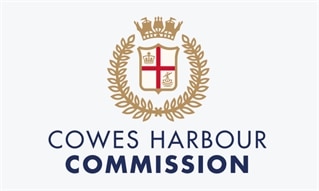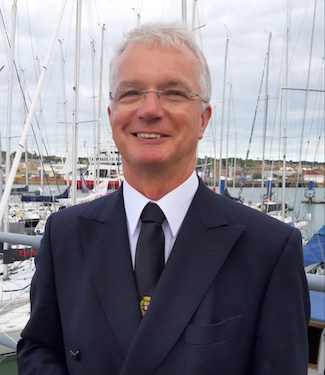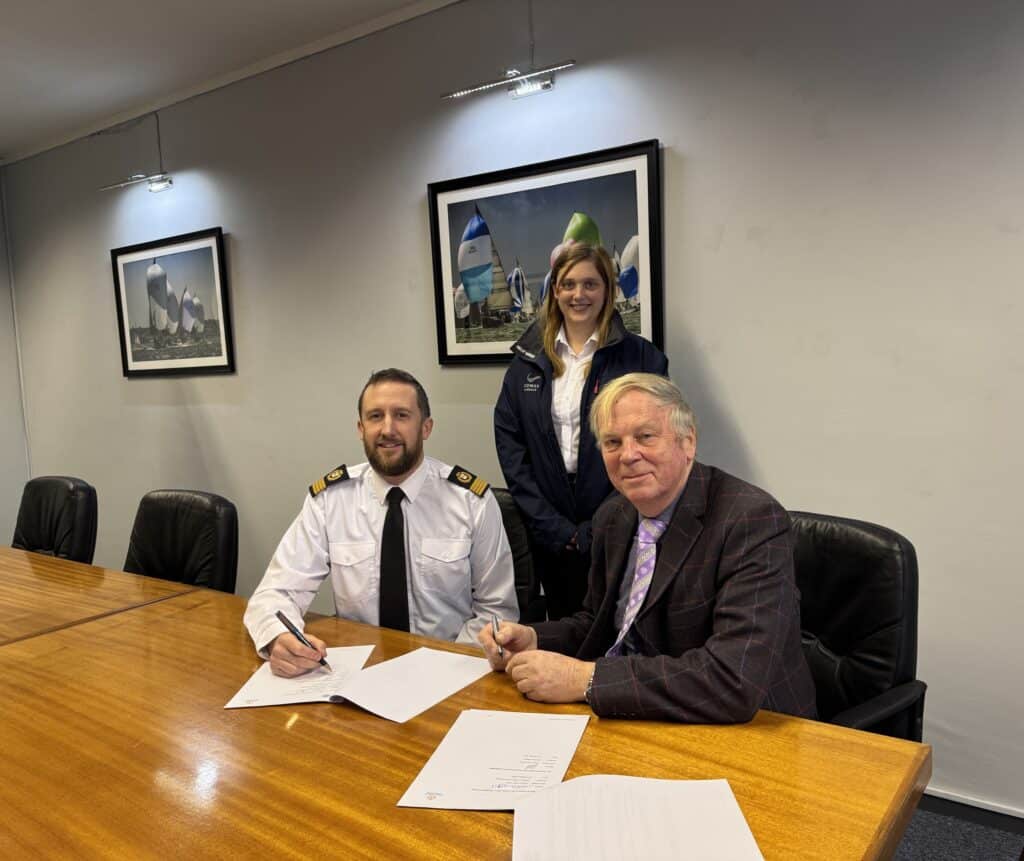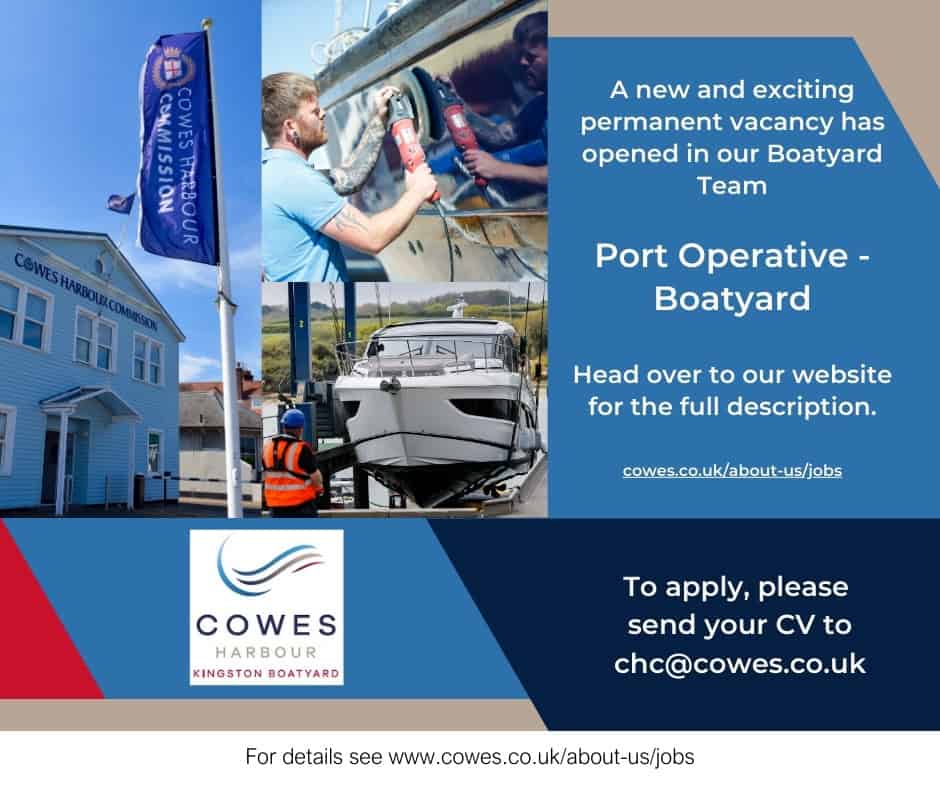
Island writer Amber Beard talks to recently retired Stuart McIntosh.
 The Cowes Harbour Commission (CHC) has seen a sea change in the past twenty years; governance and statutes have been modernised and revised, assets have been acquired, built, and realised and the future of the harbour secured for future generations and all of this has happened under the watchful eye of Stuart McIntosh who retired earlier this year.
The Cowes Harbour Commission (CHC) has seen a sea change in the past twenty years; governance and statutes have been modernised and revised, assets have been acquired, built, and realised and the future of the harbour secured for future generations and all of this has happened under the watchful eye of Stuart McIntosh who retired earlier this year.
A seafarer since the age of sixteen when he joined the Merchant Navy serving with Esso until he progressed and gained his Master’s certificate, Stuart has had a career spanning the sailing of a myriad of vessels from merchant ships to his own built 43ft cruising yacht constructed in a field in Warwickshire until he became Captain of the superyacht Kingdom 5KR. He joined the CHC in 1996 as Deputy Harbour Master, eventually taking on the Harbour Master’s role from Henry Wrigley at the end of 1998 and spent the next twenty years implementing changes that would be the catalyst for the modern CHC and its government model ensuring a robust and inclusive Trust Port.
The Cowes Harbour Commission was set up as a Trust Port in 1897 so has been one for over 120 years. There are three types of port in the UK, commercial and privately owned and responsible to their shareholders to maximise profits, Trust Ports, which are independent ports set up with their own statutes – there are over 100 in the UK which vary in size from Dover and Milford Haven down to mid-size like Cowes and then on to the very small Cornish ports, and then there are municipal ports run by local authorities, for instance Portsmouth and Newport here on the Island. Back in 2000 the government looked at whether Trust Ports were still a reasonable business governance model for this range of 100 ports and after they had done their full review decided that they were a good model but needed to be modernised and a new guide for good governance came out, part of which was to make sure that the Trust Ports were being managed to the maximum advantage of the stakeholders. Unlike commercial ports where all the profits go back to the shareholders, Trust Ports are effectively independent and answerable to their stakeholders and what was found as part of the review was that whilst certain Trust Ports were being run well, there were many Trust Ports that were not maximising the assets of the ports and harbours. The government therefore introduced new recommendations and guidance for Trust Ports based on modern good business governance principles. One of the recommendations was that boards should be changed from a representative board made up of stakeholders and representatives to an independent board who were chosen for their skills and experience – so changing their governance by changing their statute. CHC was one of the first Trust Ports that went through this modernisation process and so moved from a board of representative commissioners who were made up of local town councillors, representatives from businesses like Red Funnel and commercial ports to an independent board.
Having taken on the new governance model and independent board, that then gave CHC the ability to deliver the new strategy. The commissioners were chosen through an open recruitment process and there were nine commissioners (plus the Harbour Master/Chief Executive) who were advertised for in an open process, looking for a wide range of skills and experience that would enable CHC to be best placed to take all of the strategic and business decisions. The selection panel was made up of the existing chairman of the board, an independent person, and a stakeholder representative. Commissioners are appointed for a term of three years and at the same time there was an advisory committee set up which was also part of the new guidance, made up of representatives of all the stakeholder groups: for example, yacht racing, cruising, commercial shipping, marine industry and Cowes and East Cowes town councils, with its own independent chairman and CHC has to consult this committee on anything that will have a significant potential impact on the harbour.
Stuart comments, “Many Trust Ports in the past were just looking very solely at their statutory harbour duties, which will always remain CHC’s priority – the safety of the harbour and our responsibilities. However, I think that one thing the Trust Port review really brought into focus was the importance of harbour authorities looking at the long-term management, sustainability and development of ports and harbours, including Cowes, a core key asset for the Isle of Wight. Cowes Harbour and the River Media is the main gateway to the whole of the Island – not just transportation and commercial shipping but also industry, commerce, leisure, and the natural environment. It’s vital therefore that this harbour asset is maintained and managed to the benefit of all of the stakeholders and by having the new governance model, this ensures that we have a long-term strategy setting out the aims and objectives of the harbour and consulting the stakeholders while making sure that the harbour commissioners are acting as guardians to nurture it for future generations – we are very much custodians. We’ve put efforts into large investment projects like Trinity Landing and the Cowes Breakwater, which is probably the single largest investment that CHC has done for the long-term wellbeing and protection of the harbour – we know that it can be a bit Marmite, but it’ll be future generations who will determine the true value of it. Making the harbour truly sheltered has been an aspiration of CHC for a long time going back to the time of Admiral de Horsey who came up with the original concept in 1860 and we are constantly looking at how we can improve the infrastructure of the harbour. It’s the efforts of the Commission over the last twenty years that has enabled CHC to be in a position where we can look to deliver large projects, and one of the encouragements of the Trust Port review was to make sure that harbours were run on business lines to look to develop assets and facilities without using our statutory position to our commercial advantage but by looking to develop infrastructure and then putting the surpluses back into the harbour.
“CHC has changed a lot over the last twenty years – we’ve gone from a traditional statutory harbour authority where we were just running the safety side and allowing some moorings to being a business, developing and improving and now it’s working and listening to stakeholders as an open entity developing assets for everybody. Cowes is full of opportunity and one of its strengths is the tradition of Cowes – the yacht clubs, the Squadron, the High Street and the brand of Cowes is steeped in history and yachting. Cowes Harbour is also a commercial working and transport port, which needs to support and facilitate the vital marine employment sectors. To go with these strengths, the view of the Commission is that you have to give the customers the service and the product that they want at a reasonable price. But we can’t rest on our laurels and we have to constantly move forward, providing good facilities, service, and the ability to interconnect and communicate between the water and the High Street and that’s why we are constantly working with other stakeholders to improve that offer.
“It was a privilege to have the Harbour Master and Chief Executive’s role for over twenty years and I’ve been incredibly lucky to have been a part of some fantastic events including the America’s Cup Jubilee in 2001, the 2011 start of the Clipper Round the World Yacht Race and the Queen’s visit to Cowes as part of her Diamond Jubilee in 2012. I’m also grateful to have had a board of commissioners over that period who have been dedicated, with a tremendous range of skills and experience who have been putting back into the community for the next generation and also making sure that we are communicating with the stakeholders. We have to look after this asset and develop it working with the Isle of Wight Council, Cowes and East Cowes Councils and other stakeholders.”

 The Cowes Harbour Commission (CHC) has seen a sea change in the past twenty years; governance and statutes have been modernised and revised, assets have been acquired, built, and realised and the future of the harbour secured for future generations and all of this has happened under the watchful eye of Stuart McIntosh who retired earlier this year.
The Cowes Harbour Commission (CHC) has seen a sea change in the past twenty years; governance and statutes have been modernised and revised, assets have been acquired, built, and realised and the future of the harbour secured for future generations and all of this has happened under the watchful eye of Stuart McIntosh who retired earlier this year. 

